Paper Menu >>
Journal Menu >>
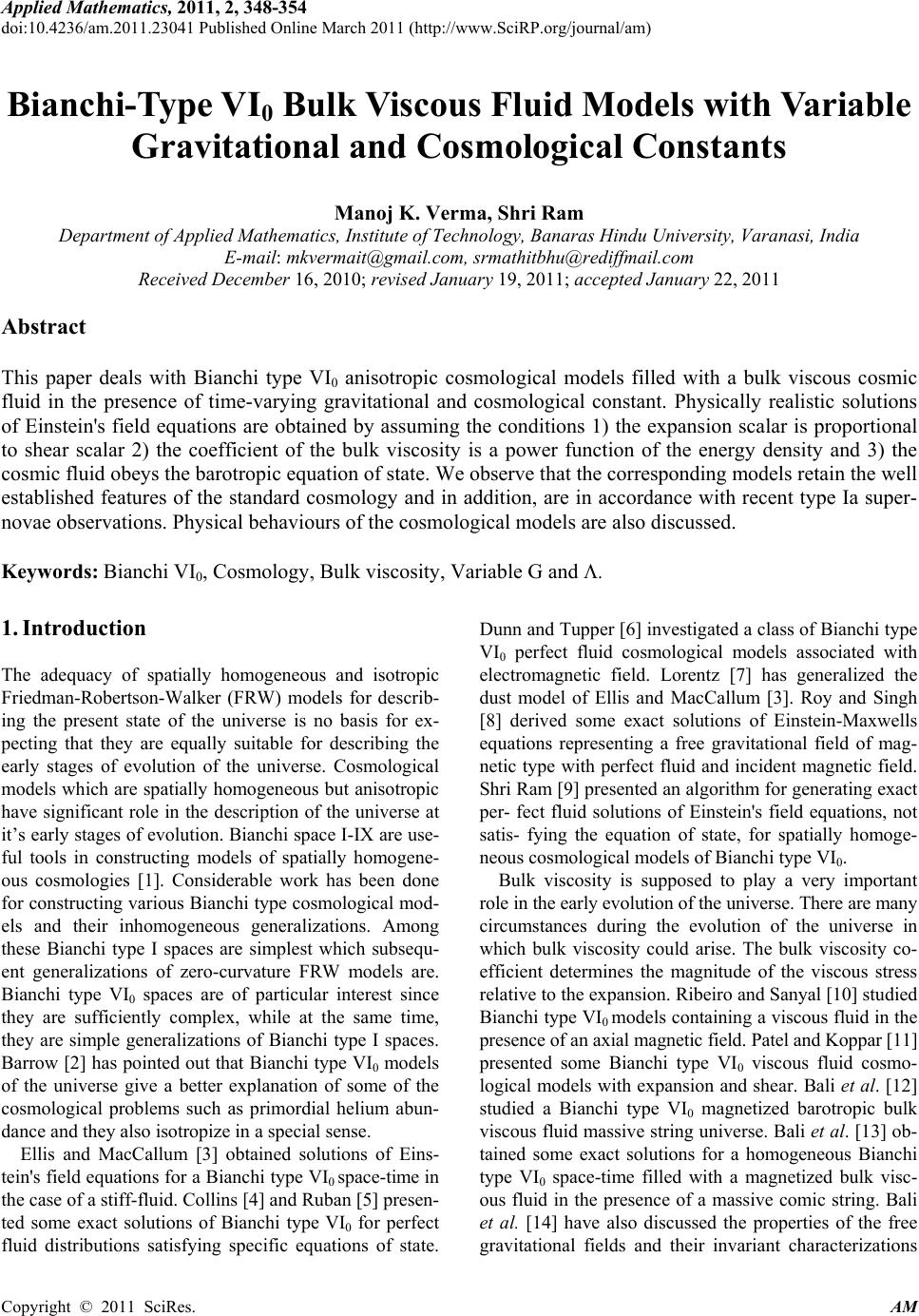 Applied Mathematics, 2011, 2, 348-354 doi:10.4236/am.2011.23041 Published Online March 2011 (http://www.SciRP.org/journal/am) Copyright © 2011 SciRes. AM Bianchi-Type VI0 Bulk Viscous Fluid Models with Variable Gravitational and Cosmological Constants Manoj K. Verma, Shri Ram Department of Applied Mathema tics, Institute of Technology, Ba naras Hindu University, Varanasi, India E-mail: mkvermait@gmail.com, srmathitbhu@rediffmail.com Received December 16, 2010; revised January 19, 2011; accepted January 22, 2011 Abstract This paper deals with Bianchi type VI0 anisotropic cosmological models filled with a bulk viscous cosmic fluid in the presence of time-varying gravitational and cosmological constant. Physically realistic solutions of Einstein's field equations are obtained by assuming the conditions 1) the expansion scalar is proportional to shear scalar 2) the coefficient of the bulk viscosity is a power function of the energy density and 3) the cosmic fluid obeys the barotropic equation of state. We observe that the corresponding models retain the well established features of the standard cosmology and in addition, are in accordance with recent type Ia super- novae observations. Physical behaviours of the cosmological models are also discussed. Keywords: Bianchi VI0, Cosmology, Bulk viscosity, Variable G and . 1. Introduction The adequacy of spatially homogeneous and isotropic Friedman-Robertson-Walker (FRW) models for describ- ing the present state of the universe is no basis for ex- pecting that they are equally suitable for describing the early stages of evolution of the universe. Cosmological models which are spatially homogeneous but anisotropic have significant role in the description of the universe at it’s early stages of evolution. Bianchi space I-IX are use- ful tools in constructing models of spatially homogene- ous cosmologies [1]. Considerable work has been done for constructing various Bianchi type cosmological mod- els and their inhomogeneous generalizations. Among these Bianchi type I spaces are simplest which subsequ- ent generalizations of zero-curvature FRW models are. Bianchi type VI0 spaces are of particular interest since they are sufficiently complex, while at the same time, they are simple generalizations of Bianchi type I spaces. Barrow [2] has poin ted out that Bianchi type VI0 models of the universe give a better explanation of some of the cosmological problems such as primordial helium abun- dance and they also isotropize in a special sense. Ellis and MacCallum [3] obtained solutions of Eins- tein's field equations for a Bianchi type VI0 space-time in the case of a stiff-fluid. Collins [4] and Ruban [5 ] presen- ted some exact solutions of Bianchi type VI0 for perfect fluid distributions satisfying specific equations of state. Dunn and Tupper [6] investigated a class of Bianchi type VI0 perfect fluid cosmological models associated with electromagnetic field. Lorentz [7] has generalized the dust model of Ellis and MacCallum [3]. Roy and Singh [8] derived some exact solutions of Einstein-Maxwells equations representing a free gravitational field of mag- netic type with perfect fluid and incident magnetic field. Shri Ram [9] presented an algorithm for generating exact per- fect fluid solutions of Einstein's field equations, not satis- fying the equation of state, for spatially homoge- neous cosmological models of Bianchi type VI0. Bulk viscosity is supposed to play a very important role in the early evolution of the universe. There are many circumstances during the evolution of the universe in which bulk viscosity could arise. The bulk viscosity co- efficient determines the magnitude of the viscous stress relative to the expansion. Ribeiro and Sanyal [10] studied Bianchi type VI0 models containing a viscous fluid in the presence of an axial magnet i c fiel d. Pat el and Ko ppar [11] presented some Bianchi type VI0 viscous fluid cosmo- logical models with expansion and shear. Bali et al. [12] studied a Bianchi type VI0 magnetized barotropic bulk viscous fluid massive string universe. Bali et al. [13] ob- tained some exact solutions for a homogeneous Bianchi type VI0 space-time filled with a magnetized bulk visc- ous fluid in the presence of a massive comic string. Bali et al. [14] have also discussed the properties of the free gravitational fields and their invariant characterizations  M. K. VERMA ET AL. Copyright © 2011 SciRes. AM 349 and imposing certain conditions over the free gravitatio- nal fields. The cosmological constant and the gravitational constant G are two parameters present in Einstein's field equations. The Newtonian constant G plays the role of coupling constant between geometry and matter in Eins- tein's field equations. There have been numerous mod- ifications of general relativity in which G varies with time in order to achieve possible unification of gravita- tion and elementary particle physics or to incorporate Mach's principle in general relativity. From the point of view of incorporating particle physics into Einstein's theory of gravitation, the simplest approach is to in terpret the cosmological constant in terms of quantum me- chanics and the physics of the vacuum [15]. The term has also been interpreted in terms of Higg's scalar field [16]. Linde [17] proposed that term is a function of temperature and related it to the process of broken sym- metries. The cosmological constant problem related to the existence of has been extensively discussed in lite- rature. A phenomena logical solution to this problem is suggested by considering as a function of time, so that it was large in the early universe and got reduces with the expansion of the universe [18]. A number of authors e.g. Kalligas et al. [19], Arbab [20], Abdussattar and Vish- wakarma [21] proposed linking of variations of G and within the framework of general relativity. This approach is appealing as it leaves the form of Einstein equations formally unchanged by allowing a variation of G to be accompanied by change in . Pradhan and Yadav [22] investigated bulk viscous anisotropic cosmological mod- els with variable G and . Pradhan et al. [23] derived FRW universe with verying G and . Since Bianchi type I spaces are subsequent generalization of zero curvature FRW models, Singh et al. [24] obtained some Bianchi type I models with variable G and . Singh et al. [25] obtained early viscous universe with variable G and . Singh and Tiwari [26] presented Bianchi type I models in the presence of a perfect fluid with time varying G and in general relativity. Singh and Kotambkar [27] dis- cussed cosmological models with variable G and in space-times of higher dimensions. Singh and Kale [28] dealt with Bianchi type I, Kantowski-Sachs and Bianchi type III anisotropic models of the universe filled with a bulk viscous cosmic fluid in the presence of variable G and . Bali and Tinker [29] investigated Bianchi type III bulk viscous barotropic fluid cosmological model with variab le G and which leads to inflationary phase of the universe. Recently, Verma and Shri Ram [30] obtained Bianchi type III bulk viscous barotropic fluid cosmolog- ical model with variable G and in simple and syste- matic way. Homogeneous cosmologies with Bianchi type VI0 space filled with perfect fluids, satisfying specific equation of state linking the pressure and matter energy density are widely used to study different properties of solutions of Einstein's field equations. Pradhan and Bali [31] presented magnetized Bianchi type VI0 barotropic massive string universe with decaying vacuum energy density. Recently, a new class of LRS Bianchi type VI0 universe with free gravitational field and decaying va- cuum energy is obtained by Pradhan et al. [32]. In this paper, we investigate Bianchi type VI0 bulk viscous barotropic fluid cosmological models with time varying gravitational and cosmological constants. The paper is organized as follows, we present the metric and Einstein's field equation for a viscous fluid with time-de- pendent G and. We deal with solutions of the field eq- uations and we obtain solutions of the field equations under the assumptions that 1) the expansion scalar is pro- portional to the shear scalar 2) the bulk viscosity coeffi- cient is a power function of the energy de nsity and 3) the cosmic fluid obeys the barotropic equation of state. The corresponding models represent expanding, shearing and non-rotating universe which give essentially space for large time. We also discuss the physical and kinematical behaviours of Bianchi type VI0 anisotropic cosmological models. Some concluding remarks have also been given. 2. Field Equations and General Expressions We consider Bianchi type VIo metric in the form 22 2222222mx mx dsdt AdxBe dyCe dz (1) where ,and A BCare function of cosmic time t and m is a constant parameter. The energy-momentum tensor for a bulk viscous fluid distribution is given by j jj iii Tpvvpg (2) where ; p =p vii (3) Here ,,andpp are respectively, energy-density of matter, thermodynamic pressure, effective pressure and bulk viscosity coefficient. The four-velocity vector of the fluid satisfies. 1 i i vv (4) A semicolon stands for covariant differentiation. The Einstein’s field equations with time-dependent Gand are 18. 2 ijijij ij RRg GTg (5) For the line-element (1) with a bulk viscous fluid dis- tribution, the field Equation (5), in commoving frame, give rise to the following equations : 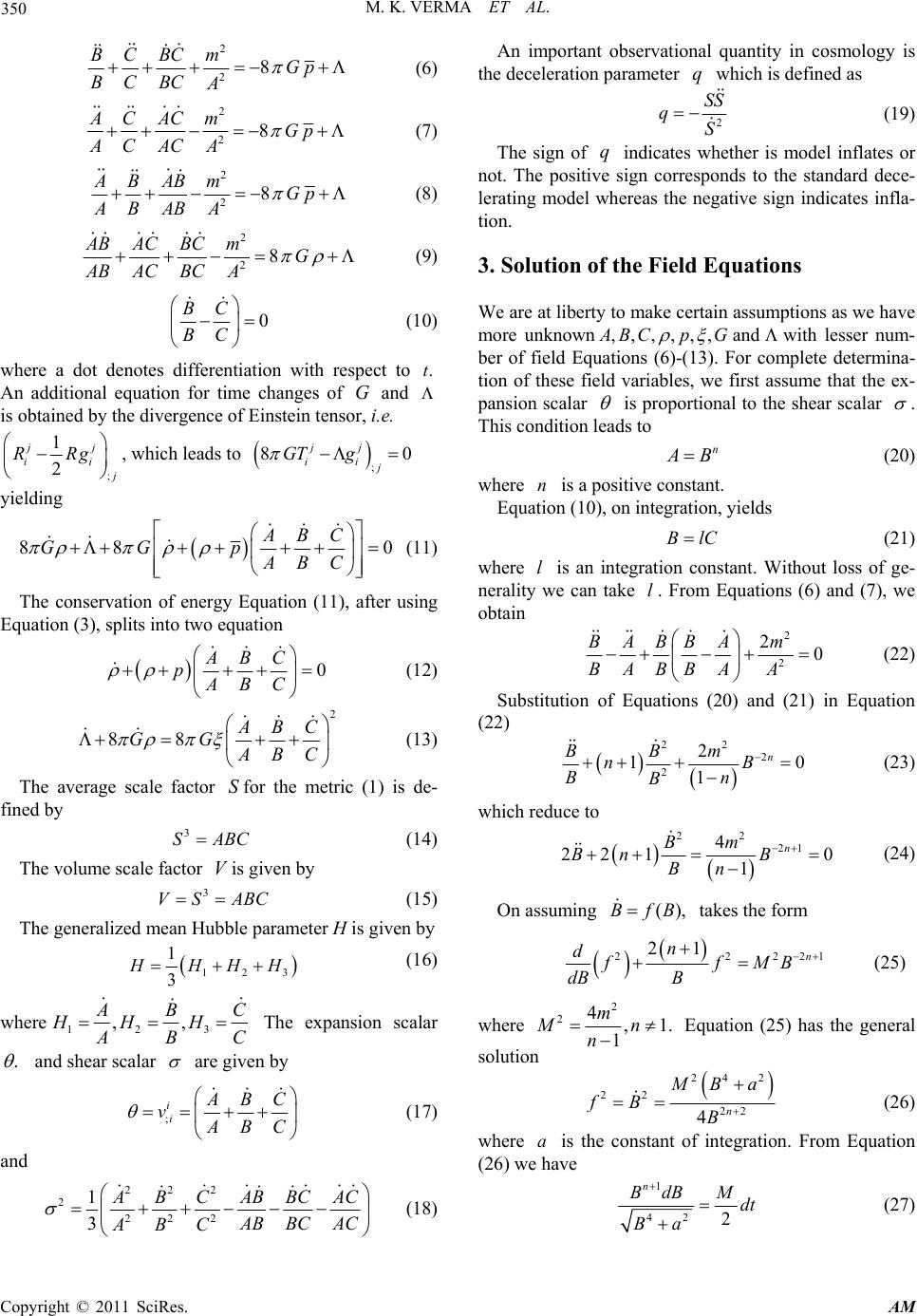 M. K. VERMA ET AL. Copyright © 2011 SciRes. AM 350 2 28 BCBCmGp BCBC A (6) 2 28 AC ACmGp AC AC A (7) 2 28 ABABm Gp ABABA (8) 2 28 ABACBC mG AB AC BCA (9) 0 BC BC (10) where a dot denotes differentiation with respect to .t An additional equation for time changes of G and is obtained by the divergence of Einstein tensor, i.e. ; 1 2 jj ii j RRg , which leads to ; 80 jj ii j GT g yielding 88 0 ABC GGp ABC (11) The conservation of energy Equation (11), after using Equation (3), splits into two equation 0 ABC pABC (12) 2 88 A BC GG A BC (13) The average scale factor Sfor the metric (1) is de- fined by 3 SABC (14) The volume scale factor Vis given by 3 V SABC (15) The generalized mean Hubble parameter H is given by 123 1 3 HHHH (16) where 123 ,, A BC HHH A BC The expansion scalar . and shear scalar are given by ; ii A BC v A BC (17) and 222 2 222 1 3 A BCAB BCAC A BBCAC ABC (18) An important observational quantity in cosmology is the deceleration parameter q which is defined as 2 SS qS (19) The sign of q indicates whether is model inflates or not. The positive sign corresponds to the standard dece- lerating model whereas the negative sign indicates infla- tion. 3. Solution of the Field Equations We are at liberty to make certain assumptions as we have more unknown,,,,,,andABCp G with lesser num- ber of field Equations (6)-(13). For complete determina- tion of these field variables, we first assume that the ex- pansion scalar is proportional to the shear scalar . This condition leads to n A B (20) where n is a positive constant. Equation (10), on integration, yields BlC (21) where l is an integration constant. Without loss of ge- nerality we can take l. From Equations (6) and (7), we obtain 2 2 20 BABBA m BABBA A (22) Substitution of Equations (20) and (21) in Equation (22) 22 2 2 2 10 1 n BBm nB Bn B (23) which reduce to 22 21 4 22 10 1 n Bm Bn B Bn (24) On assuming (),BfB takes the form 22221 21 n n dffMB dB B (25) where 2 24,1. 1 m Mn n Equation (25) has the general solution 24 2 22 22 4n M Ba fB B (26) where a is the constant of integration. From Equation (26) we have 1 42 2 n BdB M dt Ba (27) 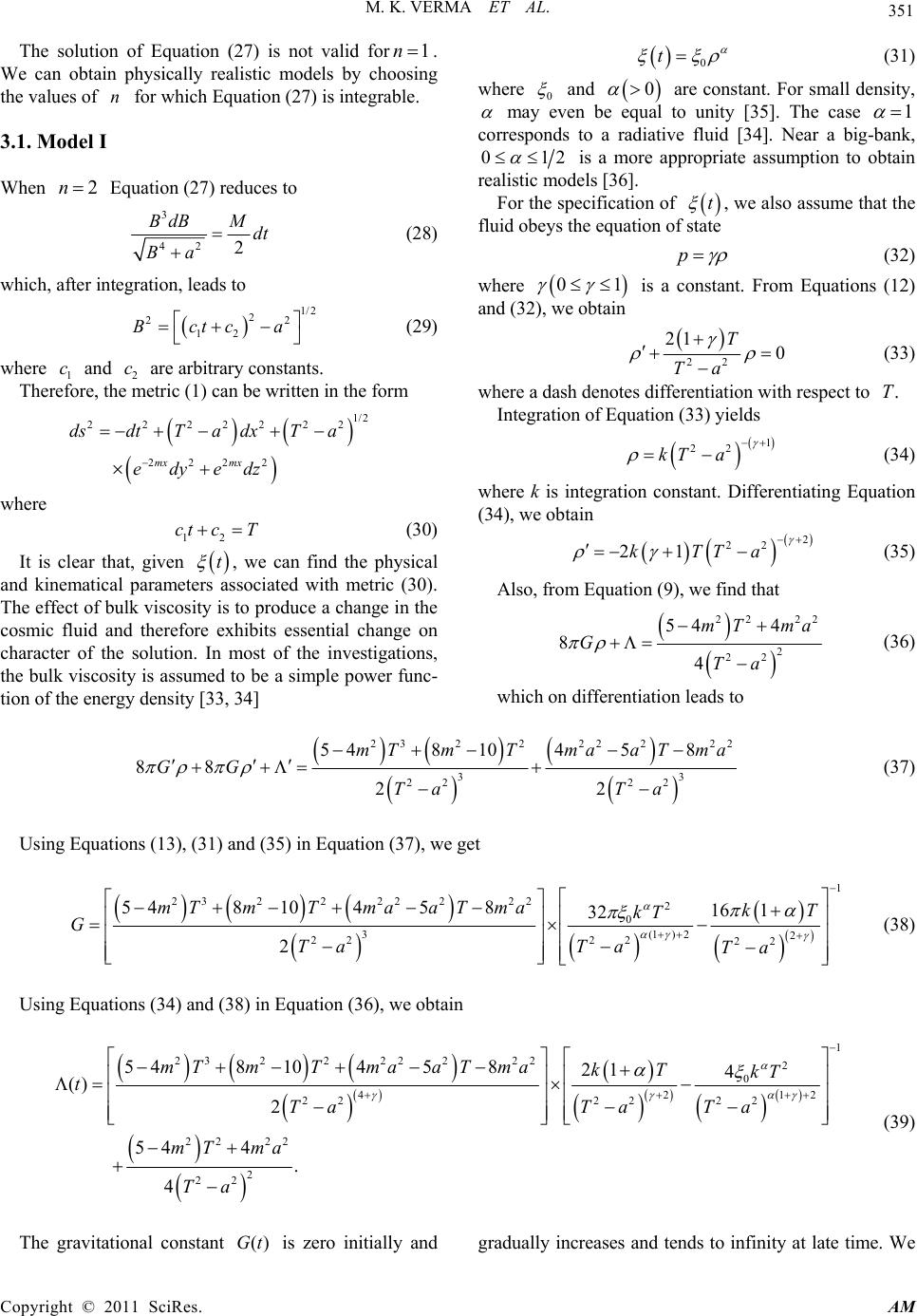 M. K. VERMA ET AL. Copyright © 2011 SciRes. AM 351 The solution of Equation (27) is not valid for1n . We can obtain physically realistic models by choosing the values of n for which Equation (27) is integrable. 3.1. Model I When 2n Equation (27) reduces to 3 42 2 BdBMdt Ba (28) which, after integration, leads to 1/ 2 2 22 12 Bctca (29) where 1 c and 2 c are arbitrary constants. Therefore, the metric (1) can be written in the form 1/ 2 2222222 2222mx mx dsdtTa dxTa edyedz where 12 ct cT (30) It is clear that, given t , we can find the physical and kinematical parameters associated with metric (30). The effect of bulk viscosity is to produce a change in the cosmic fluid and therefore exhibits essential change on character of the solution. In most of the investigations, the bulk viscosity is assumed to be a simple power func- tion of the energy density [33, 34] 0 t (31) where 0 and 0 are constant. For small density, may even be equal to unity [35]. The case 1 corresponds to a radiative fluid [34]. Near a big-bank, 012 is a more appropriate assumption to obtain realistic models [36]. For the specification of t , we also assume that the fluid obeys the equation of state p (32) where 01 is a constant. From Equations (12) and (32), we obtain 22 21 0 T Ta (33) where a dash denotes differentiation with respect to .T Integration of Equation (33) yi elds 1 22 kT a (34) where k is integration constant. Differentiating Equation (34), we obtain 2 22 21kTTa (35) Also, from Equation (9), we find that 22 22 2 22 54 4 84 mT ma GTa (36) which on differentiation leads to 232222222 33 22 22 548 10458 88 22 m TmTmaaTma GG Ta Ta (37) Using Equations (13), (31) and (35) in Equation (37), we get 1 232222 2222 0 3(1)2 2 2222 22 548 1045816 1 32 2 mTmTmaaT makT kT GTaTa Ta (38) Using Equations (34) and (38) in Equation (36), we obtain 1 232222 2222 0 4212 2222 22 22 22 2 22 548 1045821 4 () 2 544 . 4 mTmTmaaT makTkT tTaTa Ta mT ma Ta (39) The gravitational constant ()Gt is zero initially and gradually increases and tends to infinity at late time. We 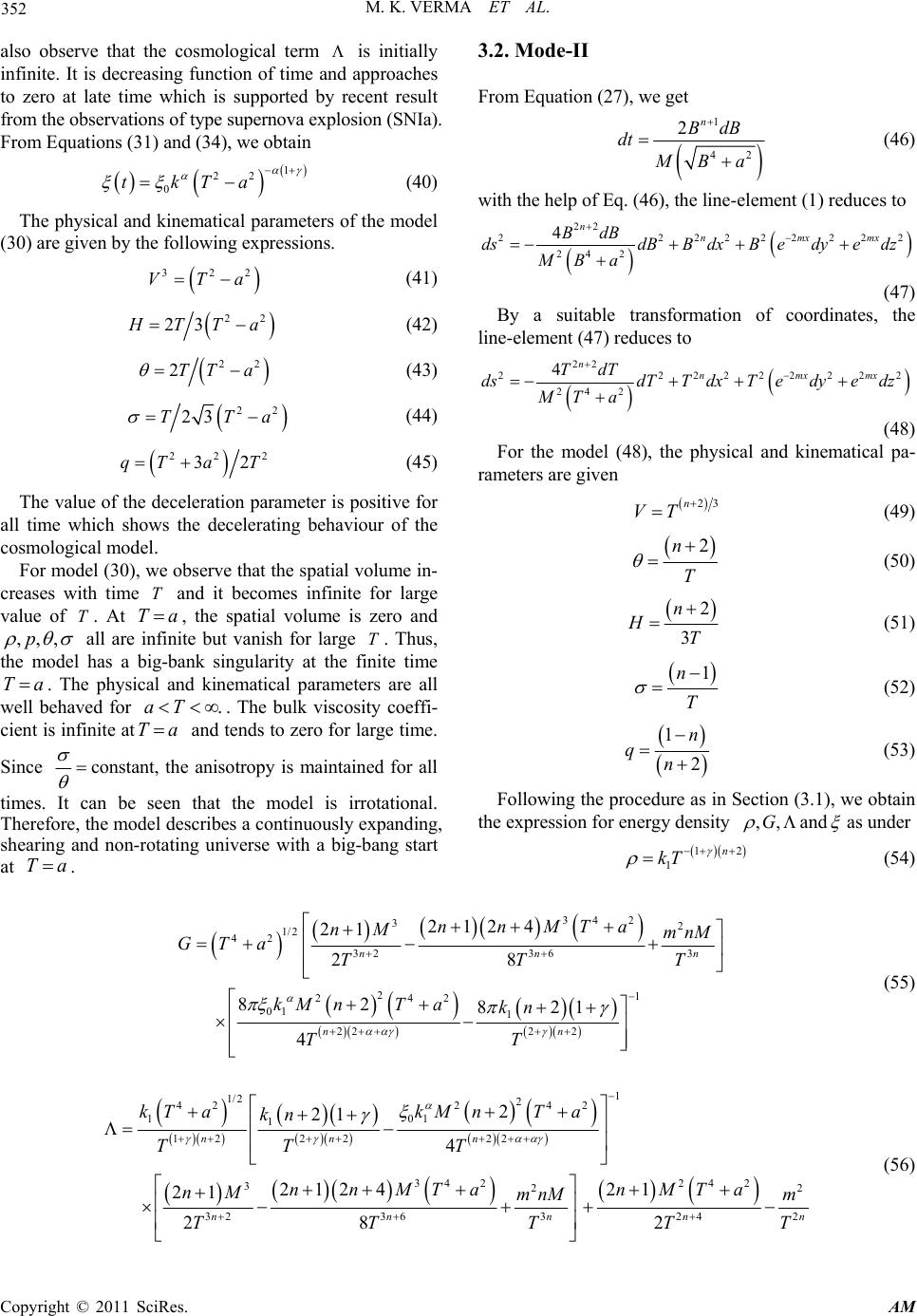 M. K. VERMA ET AL. Copyright © 2011 SciRes. AM 352 also observe that the cosmological term is initially infinite. It is decreasing function of time and approaches to zero at late time which is supported by recent result from the observations of type supernova explosion (SNIa). From Equations (31) and (34), we obtain 1 22 0 tkTa (40) The physical and kinematical parameters of the model (30) are given by the following expressions. 322 VTa (41) 22 23HTTa (42) 22 2TT a (43) 22 23TTa (44) 22 2 32qT a T (45) The value of the deceleration parameter is positive for all time which shows the decelerating behaviour of the cosmological m odel. For model (30), we observe that the spatial volume in- creases with time T and it becomes infinite for large value of T. At Ta, the spatial volume is zero and ,,,p all are infinite but vanish for large T. Thus, the model has a big-bank singularity at the finite time Ta. The physical and kinematical parameters are all well behaved for .aT . The bulk viscosity coeffi- cient is infinite atTa and tends to zero for large time. Since constant, the anisotropy is maintained for all times. It can be seen that the model is irrotational. Therefore, the model describes a continuously expanding, shearing and non-rotating universe with a big-bang start at Ta. 3.2. Mode-II From Equation (27), we get 1 42 2n BdB dt M Ba (46) with the help of Eq. (46), the line-element (1) reduces to 22 222222222 24 2 4nnmxmx BdB dsdBBdxBedyedz MB a (47) By a suitable transformation of coordinates, the line-element (47) reduces to 22 222222222 24 2 4nnmxmx TdT dsdTT dxTedyedz MT a (48) For the model (48), the physical and kinematical pa- rameters are given 23n VT (49) 2n T (50) 2 3 n HT (51) 1n T (52) 1 2 n qn (53) Following the procedure as in Section (3.1), we obtain the expression for energy density ,,G and as under 12 1n kT (54) 34 2 32 1/2 42 3236 3 21 242 01 1 222 2 2124 21 28 82 821 4 nnn nn nnMTa nM mnM GTa TTT kM nTakn TT (55) 1 1/22 422 42 101 1 12 2222 34 224 2 322 3236324 2 2 21 4 212421 21 28 2 nn n nnnnn kT akMnT a kn TT T nnMTanMTa nM mnMm TTTTT (56) 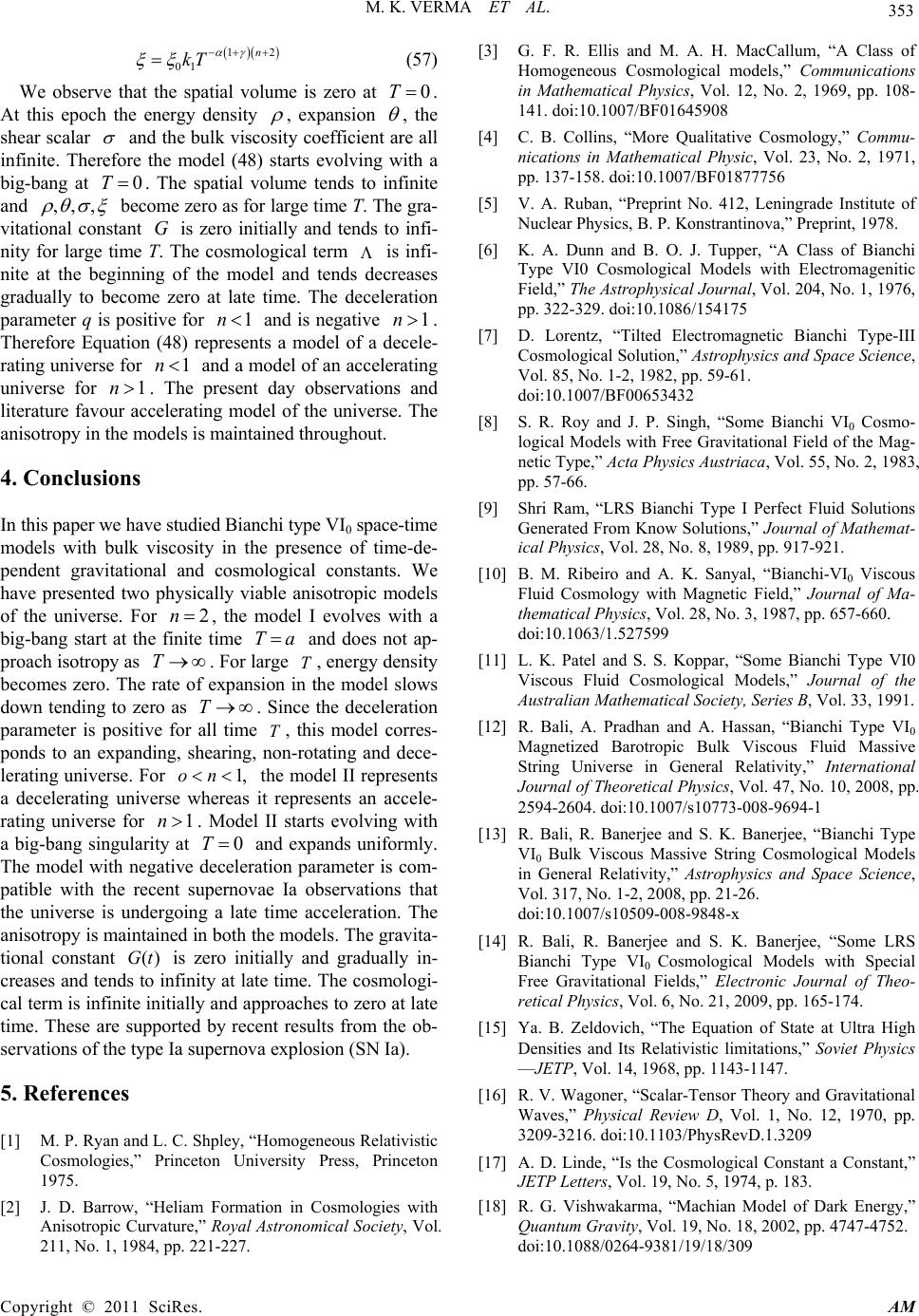 M. K. VERMA ET AL. Copyright © 2011 SciRes. AM 353 12 01 n kT (57) We observe that the spatial volume is zero at 0T . At this epoch the energy density , expansion , the shear scalar and the bulk viscosity coefficient are all infinite. Therefore the model (48) starts evolving with a big-bang at 0T. The spatial volume tends to infinite and ,,, become zero as for large time T. The gra- vitational constant G is zero initially and tends to infi- nity for large time T. The cosmological term is infi- nite at the beginning of the model and tends decreases gradually to become zero at late time. The deceleration parameter q is positive for 1n and is negative 1n. Therefore Equation (48) represents a model of a decele- rating universe for 1n and a model of an accelerating universe for 1n. The present day observations and literature favour accelerating model of the universe. The anisotropy in the models is maintained throughout. 4. Conclusions In this paper we have studied Bianchi type VI0 space-time models with bulk viscosity in the presence of time-de- pendent gravitational and cosmological constants. We have presented two physically viable anisotropic models of the universe. For 2n, the model I evolves with a big-bang start at the finite time Ta and does not ap- proach isot ropy as T. For large T, energy density becomes zero. The rate of expansion in the model slows down tending to zero as T. Since the deceleration parameter is positive for all time T, this model corres- ponds to an expanding, shearing, non-rotating and dece- lerating universe. For 1,on the model II represents a decelerating universe whereas it represents an accele- rating universe for 1n. Model II starts evolving with a big-bang singularity at 0T and expands uniformly. The model with negative deceleration parameter is com- patible with the recent supernovae Ia observations that the universe is undergoing a late time acceleration. The anisotropy is maintained in both the models. The gravita- tional constant ()Gt is zero initially and gradually in- creases and tends to infinity at late time. The cosmologi- cal term is infinite initially and approaches to zero at late time. These are supported by recent results from the ob- servations of the type Ia supernova explosion (SN Ia). 5. References [1] M. P. Ryan and L. C. Shpley, “Homogeneous Relativistic Cosmologies,” Princeton University Press, Princeton 1975. [2] J. D. Barrow, “Heliam Formation in Cosmologies with Anisotropic Curvature,” Royal Astronomical Society, Vol. 211, No. 1, 1984, pp. 221-227. [3] G. F. R. Ellis and M. A. H. MacCallum, “A Class of Homogeneous Cosmological models,” Communications in Mathematical Physics, Vol. 12, No. 2, 1969, pp. 108- 141. doi:10.1007/BF01645908 [4] C. B. Collins, “More Qualitative Cosmology,” Commu- nications in Mathematical Physic, Vol. 23, No. 2, 1971, pp. 137-158. doi:10.1007/BF01877756 [5] V. A. Ruban, “Preprint No. 412, Leningrade Institute of Nuclear Physics, B. P. Konstrantinova,” Preprint, 1978. [6] K. A. Dunn and B. O. J. Tupper, “A Class of Bianchi Type VI0 Cosmological Models with Electromagenitic Field,” The Astrophysical Journal, Vol. 204, No. 1, 1976, pp. 322-329. doi:10.1086/154175 [7] D. Lorentz, “Tilted Electromagnetic Bianchi Type-III Cosmological Solution,” Astrophysics and Space Science, Vol. 85, No. 1-2, 1982, pp. 59-61. doi:10.1007/BF00653432 [8] S. R. Roy and J. P. Singh, “Some Bianchi VI0 Cosmo- logical Models with Free Gravitational Field of the Mag- netic Type,” Acta Physics Austriaca, Vol. 55, No. 2, 1983, pp. 57-66. [9] Shri Ram, “LRS Bianchi Type I Perfect Fluid Solutions Generated From Know Solutions,” Journal of Mathemat- ical Physics, Vol. 28, No. 8, 1989, pp. 917-921. [10] B. M. Ribeiro and A. K. Sanyal, “Bianchi-VI0 Viscous Fluid Cosmology with Magnetic Field,” Journal of Ma- thematical Physics, Vol. 28, No. 3, 1987, pp. 657-660. doi:10.1063/1.527599 [11] L. K. Patel and S. S. Koppar, “Some Bianchi Type VI0 Viscous Fluid Cosmological Models,” Journal of the Australian Mathematical Society, Series B, Vol. 33, 1991. [12] R. Bali, A. Pradhan and A. Hassan, “Bianchi Type VI0 Magnetized Barotropic Bulk Viscous Fluid Massive String Universe in General Relativity,” International Journal of Theoretical Physics, Vol. 47, No. 10, 2008, pp. 2594-2604. doi:10.1007/s10773-008-9694-1 [13] R. Bali, R. Banerjee and S. K. Banerjee, “Bianchi Type VI0 Bulk Viscous Massive String Cosmological Models in General Relativity,” Astrophysics and Space Science, Vol. 317, No. 1-2, 2008, pp. 21-26. doi:10.1007/s10509-008-9848-x [14] R. Bali, R. Banerjee and S. K. Banerjee, “Some LRS Bianchi Type VI0 Cosmological Models with Special Free Gravitational Fields,” Electronic Journal of Theo- retical Physics, Vol. 6, No. 21, 2009, pp. 165-174. [15] Ya. B. Zeldovich, “The Equation of State at Ultra High Densities and Its Relativistic limitations,” Soviet Physics —JETP, Vol. 14, 1968, pp. 1143-1147. [16] R. V. Wagoner, “Scalar-Tensor Theory and Gravitational Waves,” Physical Review D, Vol. 1, No. 12, 1970, pp. 3209-3216. doi:10.1103/PhysRevD.1.3209 [17] A. D. Linde, “Is the Cosmological Constant a Constant,” JETP Letters, Vol. 19, No. 5, 1974, p. 183. [18] R. G. Vishwakarma, “Machian Model of Dark Energy,” Quantum Gravity, Vol. 19, No. 18, 2002, pp. 4747-4752. doi:10.1088/0264-9381/19/18/309 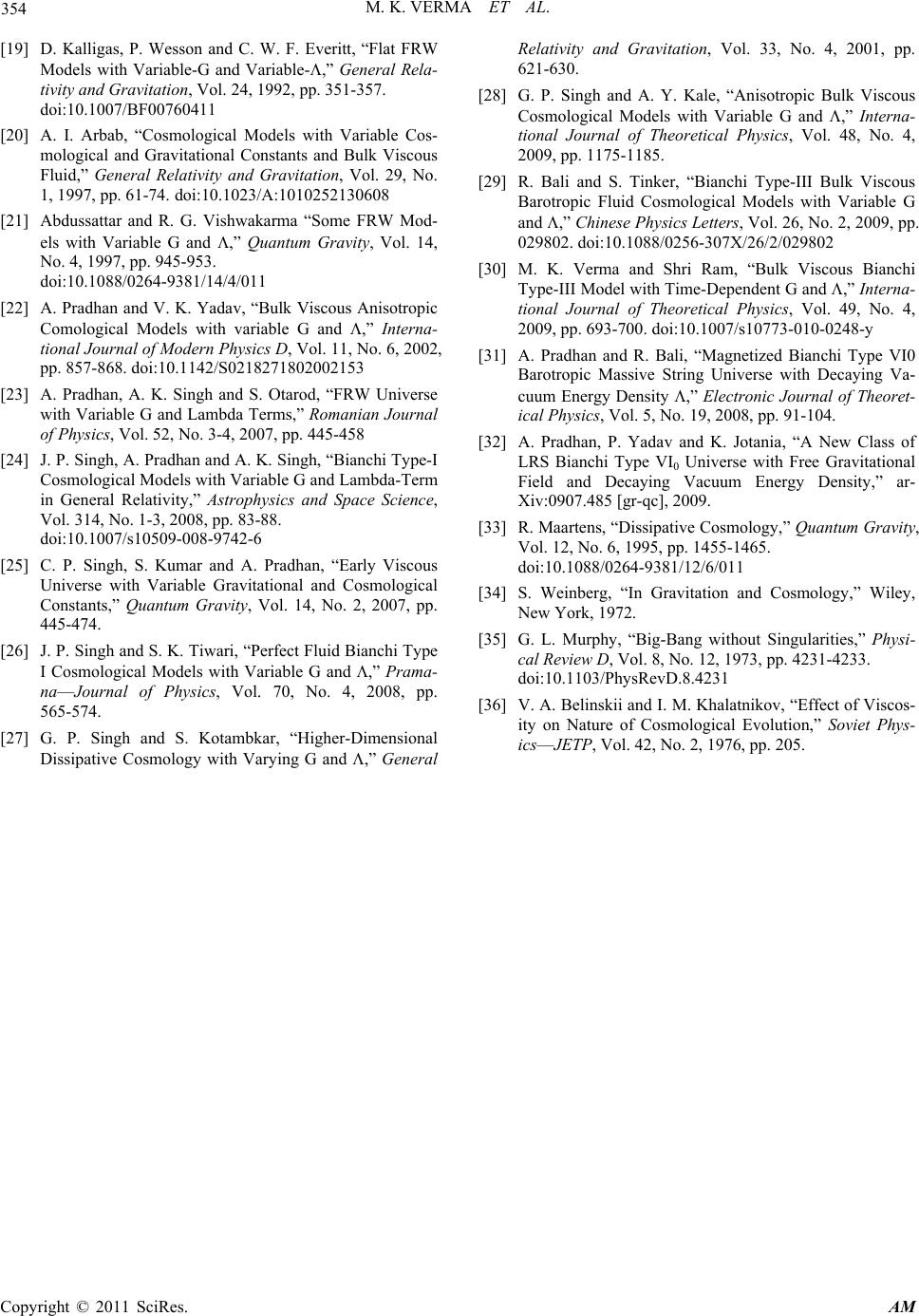 M. K. VERMA ET AL. Copyright © 2011 SciRes. AM 354 [19] D. Kalligas, P. Wesson and C. W. F. Everitt, “Flat FRW Models with Variable-G and Variable-,” General Rela- tivity and Gravitation, Vol. 24, 1992, pp. 351-357. doi:10.1007/BF00760411 [20] A. I. Arbab, “Cosmological Models with Variable Cos- mological and Gravitational Constants and Bulk Viscous Fluid,” General Relativity and Gravitation, Vol. 29, No. 1, 1997, pp. 61-74. doi:10.1023/A:1010252130608 [21] Abdussattar and R. G. Vishwakarma “Some FRW Mod- els with Variable G and ,” Quantum Gravity, Vol. 14, No. 4, 1997, pp. 945-953. doi:10.1088/0264-9381/14/4/011 [22] A. Pradhan and V. K. Yadav, “Bulk Viscous Anisotropic Comological Models with variable G and ,” Interna- tional Journal of Modern Physics D, Vol. 11, No. 6, 2002, pp. 857-868. doi:10.1142/S0218271802002153 [23] A. Pradhan, A. K. Singh and S. Otarod, “FRW Universe with Variable G and Lambda Terms,” Romanian Journal of Physics, Vol. 52, No. 3-4, 2007, pp. 445-458 [24] J. P. Singh, A. Pradhan and A. K. Singh, “Bianchi Type-I Cosmological Models with Variable G and Lambda-Term in General Relativity,” Astrophysics and Space Science, Vol. 314, No. 1-3, 2008, pp. 83-88. doi:10.1007/s10509-008-9742-6 [25] C. P. Singh, S. Kumar and A. Pradhan, “Early Viscous Universe with Variable Gravitational and Cosmological Constants,” Quantum Gravity, Vol. 14, No. 2, 2007, pp. 445-474. [26] J. P. Singh and S. K. Tiwari, “Perfect Fluid Bianchi Type I Cosmological Models with Variable G and ,” Prama- na—Journal of Physics, Vol. 70, No. 4, 2008, pp. 565-574. [27] G. P. Singh and S. Kotambkar, “Higher-Dimensional Dissipative Cosmology with Varying G and ,” General Relativity and Gravitation, Vol. 33, No. 4, 2001, pp. 621-630. [28] G. P. Singh and A. Y. Kale, “Anisotropic Bulk Viscous Cosmological Models with Variable G and ,” Interna- tional Journal of Theoretical Physics, Vol. 48, No. 4, 2009, pp. 1175-1185. [29] R. Bali and S. Tinker, “Bianchi Type-III Bulk Viscous Barotropic Fluid Cosmological Models with Variable G and ,” Chinese Physics Letters, Vol. 26, No. 2, 2009, pp. 029802. doi:10.1088/0256-307X/26/2/029802 [30] M. K. Verma and Shri Ram, “Bulk Viscous Bianchi Type-III Model with Time-Dependent G and ,” Interna- tional Journal of Theoretical Physics, Vol. 49, No. 4, 2009, pp. 693-700. doi:10.1007/s10773-010-0248-y [31] A. Pradhan and R. Bali, “Magnetized Bianchi Type VI0 Barotropic Massive String Universe with Decaying Va- cuum Energy Density ,” Electronic Journal of Theoret- ical Physics, Vol. 5, No. 19, 2008, pp. 91-104. [32] A. Pradhan, P. Yadav and K. Jotania, “A New Class of LRS Bianchi Type VI0 Universe with Free Gravitational Field and Decaying Vacuum Energy Density,” ar- Xiv:0907.485 [gr-qc], 2009. [33] R. Maartens, “Dissipative Cosmology,” Quantum Gravity, Vol. 12, No. 6, 1995, pp. 1455-1465. doi:10.1088/0264-9381/12/6/011 [34] S. Weinberg, “In Gravitation and Cosmology,” Wiley, New York, 1972. [35] G. L. Murphy, “Big-Bang without Singularities,” Physi- cal Review D, Vol. 8, No. 12, 1973, pp. 4231-4233. doi:10.1103/PhysRevD.8.4231 [36] V. A. Belinskii and I. M. Khalatnikov, “Effect of Viscos- ity on Nature of Cosmological Evolution,” Soviet Phys- ics—JETP, Vol. 42, No. 2, 1976, pp. 205. |

